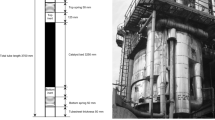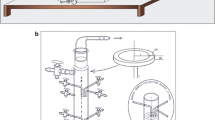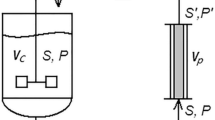Abstract
A design equation for immobilized glucose isomerase (IGI) packed bed reactor is developed assuming enzyme deactivation and substrate protection. The developed equation is used to simulate the performance of the reactor at various temperatures (50–80 °C). Enzyme deactivation is significant at high temperature. Substrate protection showed to have significant effect in reducing enzyme deactivation and increasing the enzyme half-life. Factors affecting the optimum operating temperature are discussed. The optimum operating temperature is greatly influenced by the operating period and to a lesser extent with both initial glucose concentration and glucose conversion.
Two modes of reactor operation are tested i.e., constant feed flow rate and constant conversion. Reactor operating at constant conversion is more productive than reactor operating at constant flow rate if the working temperature is higher than the optimum temperature. Although at lower temperatures than the optimum, the two modes of operation give the same result.
Similar content being viewed by others
Abbreviations
- a :
-
residual enzyme activity
- E [mg/l]:
-
concentration of active enzyme
- E a [kJ/mole]:
-
activation energy
- E 0 [mg/l]:
-
initial concentration of active enzyme
- k [Specific]:
-
kinetic parameter
- k d [h–1]:
-
first order thermal deactivation rate constant
- k e :
-
equilibrium constant
- k m [mole/l]:
-
apparent Michaelis constant
- k p [mole/l]:
-
Michaelis constant for product
- k s [mole/l]:
-
Michaelis constant for substrate
- k 0 [Specific]:
-
pre-exponential factor
- Q [1/h]:
-
volumetric flow rate
- ¯Q [1/h]:
-
average volumetric flow rate
- R [kJ/mol·k]:
-
ideal gas constant
- s′ [mole/l]:
-
apparent substrate concentration
- s [mole/l]:
-
substrate concentration
- s e [mole/l]:
-
substrate concentration at equilibrium
- s 0 [mole/l]:
-
substrate concentration at reactor inlet
- p [mole/l]:
-
product concentration
- p e [mole/l]:
-
product concentration at equilibrium
- P r [mole fructose/l·h]:
-
reactor productivity
- T [k]:
-
temperature
- t [h]:
-
time
- t p [h]:
-
operating time
- V [l]:
-
reactor volume
- v [mole/l·h]:
-
reaction rate
- v′ [mole/l]:
-
reaction rate under enzyme deactivation and substrate protection
- v m [mole/l·h]:
-
maximum apparent reaction rate
- v p [mole/l·h]:
-
maximum reaction rate for product
- v s [mole/l·h]:
-
maximum reaction rate for substrate
- x :
-
substrate fractional conversion
- x e :
-
substrate fractional conversion at equilibrium
- η :
-
effectiveness factor
- \(\bar \eta \) :
-
mean effectiveness factor
- σ :
-
substrate protection factor
- τ [h]:
-
residence time
- \(\bar \tau \) [h]:
-
average residence time
- τ 0 [h]:
-
initial residence time
References
Marshall, R.O.;Kooi, E.R.: Enzymatic conversion of D-glucose to D-fructose. Science 125 (1957) 648–649
Van Tilburg, R.: Enzymatic isomerization of corn starch-based glucose syrups. In: Starch conversion technology. Edited by G.M.A. Van Beynum and J.A. Roels, Marcell Dekker 1985
Ryu, D.Y.;Chung, S.H.;Katoh, K.: Performance of the continuous glucose isomerase reactor system for the production of fructose syrup. Biotechnol. Bioeng. 19 (1977) 159–184
Boersma, J.B.;Vellenga, K.;Dewilt, H.G.J.;Joosten, G.E.H.: Mass transfer effects on the rate of isomerization of D-glucose into D-fructose, catalyzed by whole-cell immobilized glucose isomerase. Biotechnol. Bioeng. 21 (1979) 1711–1724
Park, S.H.;Lee, S.B.;Ryu, D.D.Y.: Optimization of operating temperature for continuous glucose isomerase reactor system. Biotechnol. Bioeng. 23 (1981) 1237–1254
Roels, J.A.;Van Tilburg, R.: Temperature dependence of the stability and the activity of immobilized microbial cells. Adv. Chem. Ser. 106 (1979) 147–172
Chen, K.C.;Wu, J.Y.: Substrate protection of immobilized glucose isomerase. Biotechnol. Bioeng. 30 (1987) 817–824
Houng, J.Y.;Yu, H.Y.;Chen, K.C.: Analysis of substrate protection of an immobilized glucose isomerase reactor. Biotechnol. Bioeng. 41 (1993) 451–458
Illanes, A.;Zuniga, M.E.;Contreras, S.;Guerrero, A.: Reactor design for enzymatic isomerization of glucose to fructose. Bioprocess Eng. 7 (1992) 199–204
Vasic-Racki, D.;Pavlovic, N.;Cizmek, S.;Drazic, M.;Husadzic, B.: Development of reactor model for glucose isomerization catalyzed by whole-cell immobilized glucose isomerase. Bioprocess Eng. 7 (1991) 183–187
Levenspiel, O.: Chemical reaction engineering. Wiley, New York 1972
Venkatasubramanian, K.: Enzyme reactor design, kinetics and performance. In Food Process Engineering: Enzyme engineering in food processing. Edited by P. Linko and J. Larinkari, Vol.. 2, pp. 162–174. Applied Science, London 1979
Yang, S.T;Okos, M.R.: Effect of temperature on lactose hydrolysis by immobilized β-galactosidase in plug-flow reactor. Biotechnol. Bioeng. 33 (1989) 873–885
Vos, H.J.;Luyben, K. Ch. A.M.: Design strategy and process optimization for reactors with continuous transport of an immobilized enzyme. The Chemical Eng. J. 53 (1993) B1-B11
Verhoff, F.H.;Schlager, S.T.: Enzyme activity maintenance in packedbed reactors via continuous enzyme addition. Biotechnol. Bioeng. 23 (1981) 41–60
Author information
Authors and Affiliations
Rights and permissions
About this article
Cite this article
Abu-Reesh, I.M., Faqir, N.M. Simulation of glucose isomerase reactor: optimum operating temperature. Bioprocess Engineering 14, 205–210 (1996). https://doi.org/10.1007/BF01464735
Received:
Issue Date:
DOI: https://doi.org/10.1007/BF01464735




